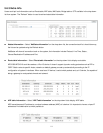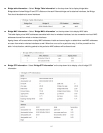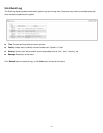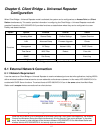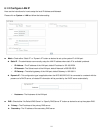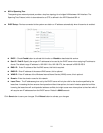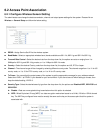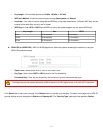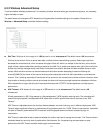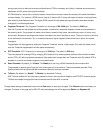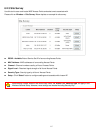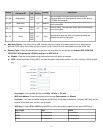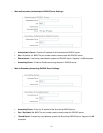
122
6.2.2 Wireless Advanced Setup
To achieve optimal wireless performance, it is necessary to tweak advance setting per requirements properly, not necessary
higher the better or lower.
The administrator can change the RTS threshold and fragmentation threshold settings for the system. Please click on
Wireless -> Advanced Setup and follow the below setting.
Slot Time : Slot time is in the range of 1~1489 and set in unit of microsecond. The default value is 20 microsecond.
Slot time is the amount of time a device waits after a collision before retransmitting a packet. Reducing the slot time
decreases the overall back-off, which increases throughput. Back-off, which is a multiple of the slot time, is the random
length of time a station waits before sending a packet on the LAN. For a sender and receiver own right of the channel the
shorter slot time help manage shorter wait time to re-transmit from collision because of hidden wireless clients or other
causes. When collision sources can be removed sooner and other senders attempting to send are listening the
channel(CSMA/CA) the owner of the channel should continue ownership and finish their transmission and release the
channel. Then, following ownership of the channel will be sooner for the new pair due to shorter slot time. However, when
long duration of existing collision sources and shorter slot time exist the owners might experience subsequent collisions.
When adjustment to longer slot time can’t improve performance then RTS/CTS could supplement and help improve
performance.
ACK Timeout : ACK timeout is in the range of 1~372 and set in unit of microsecond. The default value is 48
microsecond.
All data transmission in 802.11b/g request an “Acknowledgement” (ACK) send by receiving radio. The transmitter will
resend the original packet if correspondent ACK failed to arrive within specific time interval, also refer to as “ACK
Timeout”.
ACK Timeout is adjustable due to the fact that distance between two radio links may vary in different deployment. ACK
Timeout makes significant influence in performance of long distance radio link. If ACK Timeout is set too short, transmitter
will start to “Resend” packet before ACK is received, and throughputs become low due to excessively high re-
transmission.
ACK Timeout is best determined by distance between the radios, data rate of average environment. The Timeout value is
calculated based on round-trip time of packet with a little tolerance, So, if experiencing re-transmissions or poor
performance the ACK Timeout could be made longer to accommodate.



